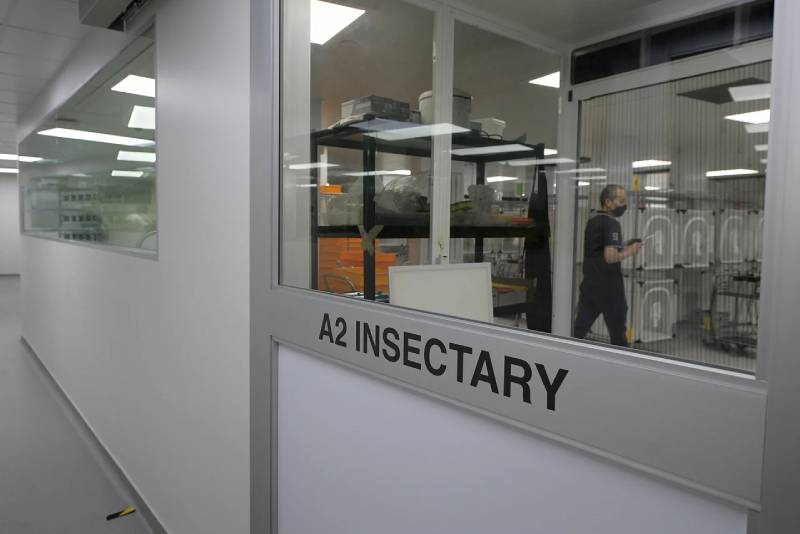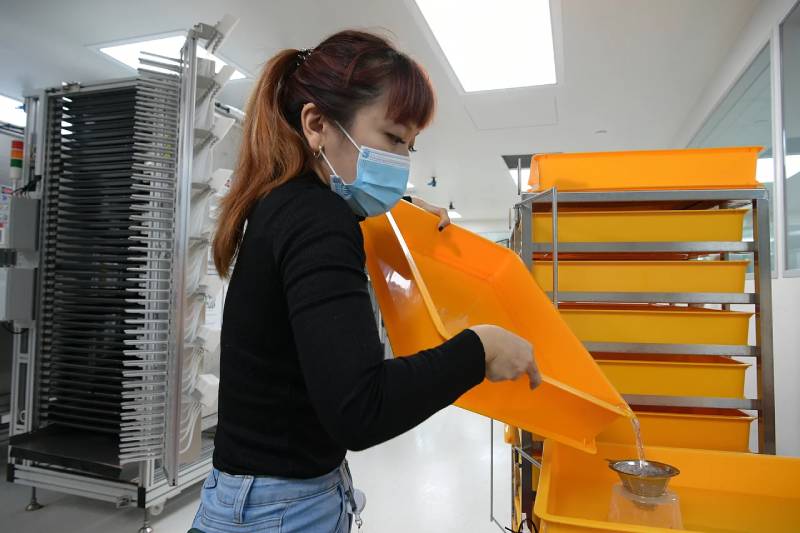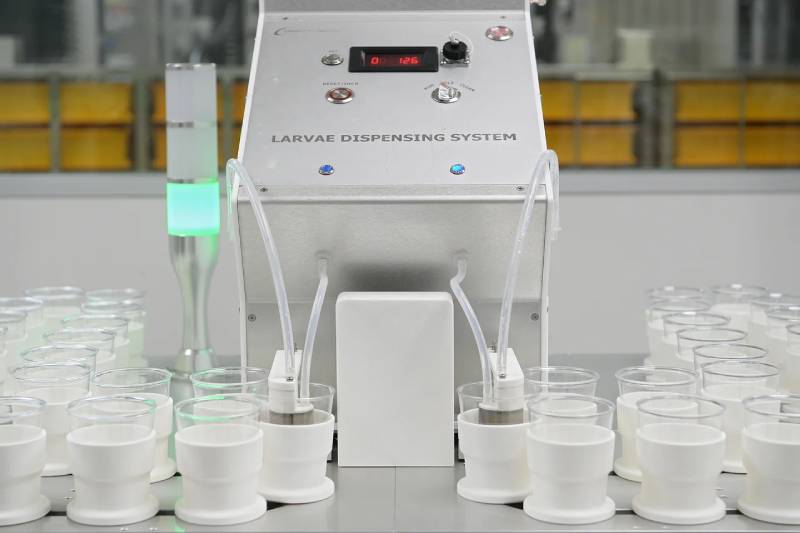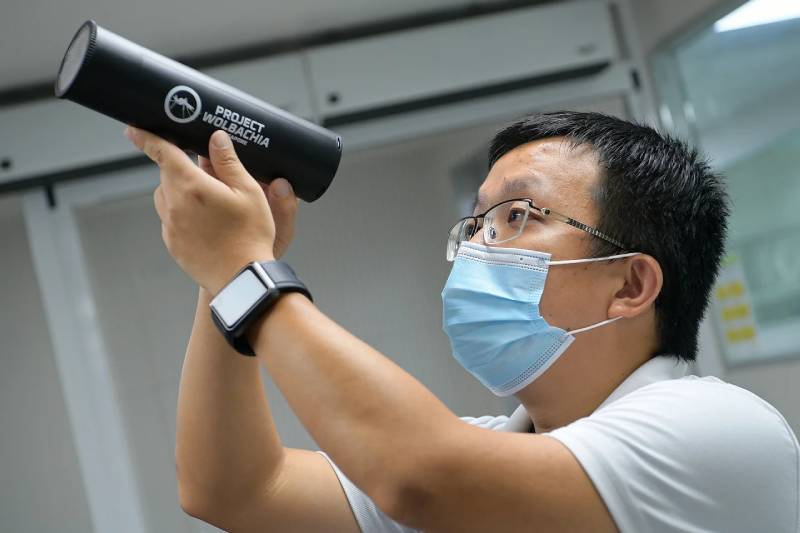In Ang Mo Kio, a place where mosquitoes are allowed to breed, even taken care of


SINGAPORE - In a white-walled room inside a production facility at a quiet industrial park in Ang Mo Kio, 28,000 mosquitoes are buzzing.
They are bred there under Project Wolbachia, one of Singapore's weapons in the war against dengue.
Under the scheme, which was launched in 2016, the mosquitoes themselves are made to fight the mosquito-borne disease.
Male Aedes aegypti mosquitoes carrying the Wolbachia bacteria are released from the facility to mate with urban female Aedes aegypti mosquitoes without Wolbachia, resulting in eggs that do not hatch and a decline in the mosquito population.
As Aedes aegypti mosquitoes are the primary vector for dengue transmission, this reduces the risk of the disease spreading.
The Republic has recorded more than 10,000 dengue cases in the first 20 weeks of this year.
The Straits Times visited the National Environment Agency's (NEA) Wolbachia mosquito production facility - the only one in Singapore - to find out the battle plan being drawn up behind the scenes.
The facility, which was launched in 2019, has rooms separated from a central hallway by sliding doors, mosquito screens, and air curtains that hiss loudly when a door is opened.
This is to ensure mosquitoes do not escape the premises, said senior scientist Deng Lu, who gave ST the tour.
Stepping into the adult insectary, we were immediately struck by how much warmer and more humid that room was compared with the adjoining air-conditioned hallway.
The insectary is kept at a constant 27 deg C and 80 per cent humidity, said Mr Deng, who is also the head of production and the automation section at the facility.

"The temperature affects the mosquitoes' lifespans, egg production, and growth speed - even half a degree difference will cause their growth speed and size to be different," he added.
Aside from the temperature difference, we were also struck by the rows and rows of netted cages, numbering about forty in total, and each buzzing with some 6,000 to 7,500 mosquitoes.
The mosquitoes in this room have only one purpose: To mate and produce eggs, which they do about thrice in the three weeks or so they are alive.
The mosquitoes in each cage can produce about 500,000 eggs, which are less than 1mm in length.
Lab staff collect these miniscule eggs on small pieces of paper and store them until more mosquitoes are needed.
The eggs can lie dormant for ten to 12 months if kept dry - though the optimal storage period is five weeks - and about 36 million eggs are stored in the facility's "egg bank" at any time.
When it is time, the eggs will be immersed in water and hatch into larvae in just half an hour or less.
"They're sort of like instant noodles - just add water," quipped Mr Deng.

This process occurs in the larvae insectary, which ST visited next.
Here, it is even warmer at 29 deg C, and a strong odour, like that of a fish tank which has not been cleaned for weeks, fills the air.
"We got used to it," said Mr Deng, adding that the smell comes from the modified fish food, which the larvae eat, sitting in water for days.
Here, strips of the paper containing the eggs are lowered into water, causing them to hatch.
After that, the larvae are poured into a machine that automatically counts them - about 30,000 in one to three minutes - a process that used to take much longer when officers had to count every single tiny larva using nothing but their eyes and a handheld tally counter at the start of the project in 2016.
This tedious process was fully replaced in 2017 by the first generation of automatic counters, which have been upgraded over the years.

The larvae are then stored in trays and fed the modified fish food over the next seven days, after which they will change into pupae.
Subsequently, a pupae scanner measures the size of the mosquito pupae, allowing scientists to determine the size range for both males and females.
This information is crucial as it lets the scientists determine the size of the sieves in the automatic sorting machines, which are then used to separate the mosquitoes by sex.
Mr Deng said that it is important that only male mosquitoes are released, as they do not bite or transmit disease.
This is because while the male Wolbachia-Aedes mosquitoes have a role to play in mating with non-Wolbachia carrying female Aedes mosquitoes, female Wolbachia-Aedes mosquitoes will simply cause a nuisance by biting more people and do not fit into Singapore's strategy of suppressing the Aedes mosquito population.
To be extra safe, sorted mosquitoes are given a small dose of X-ray radiation, rendering any females that may have slipped through - no matter how remote the chances - infertile, so that they cannot reproduce.
The pupae are then sorted into tubes of 150 each and allowed to turn into adults there.
These same tubes will then be brought to estates around Singapore, where the mosquitoes will be released.
Aside from mosquito rearing, the facility also conducts polymerase chain reaction tests on mosquitoes to ensure they contain enough Wolbachia bacteria, as well as other tests to make sure that the mosquitoes released are fit enough to compete with those in the wild.

"At the end of the day, if we release them but they cannot fly, cannot mate, they're not useful to us," said Mr Deng.
Thus far, Project Wolbachia appears to be a success, with up to 98 per cent suppression of Aedes aegypti mosquitoes and up to 88 per cent fewer dengue cases in some test areas.
But the project is still in its trial phase and cannot alone stop the spread of dengue here, highlighted Mr Deng.
He added: "Project Wolbachia is not a silver bullet. It is still important for everyone to do their part to rid their homes of stagnant water in order to fight dengue."
ALSO READ: 200 million Wolbachia Aedes mosquitoes released so far, but nationwide success takes time: NEA
This article was first published in The Straits Times. Permission required for reproduction.